 Facebook
Facebook
 X
X
 Instagram
Instagram
 TikTok
TikTok
 Youtube
Youtube
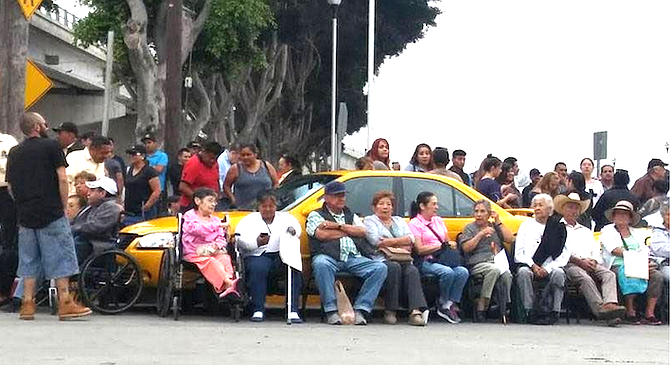
“It looks like I’m entering a ride in Six Flags,” regular border crosser Yesenia Huerta comments after using the new southbound entry to Tijuana via PedWest.
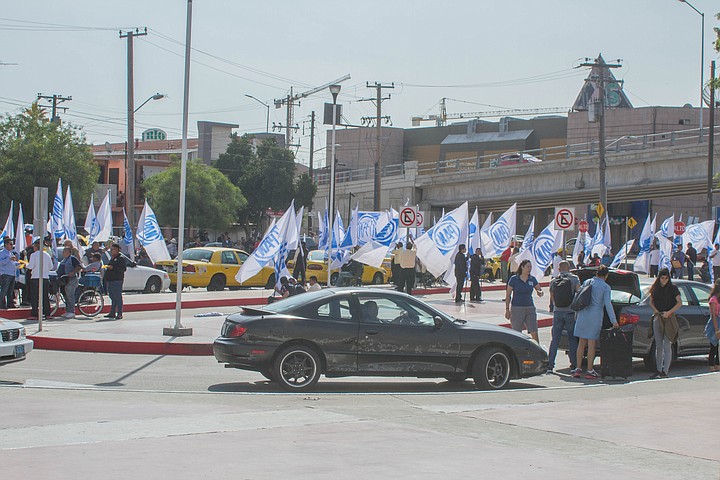
“It feels like you are getting out of prison,” differs Tamara Jiménez, another regular border crosser.
One year and two weeks after the United States opened the second option northbound through San Ysidro, known as PedWest, the new entry into Tijuana opened on Monday, July 31.

Located west of the vehicle border traffic, near Las Americas outlet mall, the second pedestrian option to enter Mexico through San Ysidro is open daily from 6:00 a.m. to 10:00 p.m.
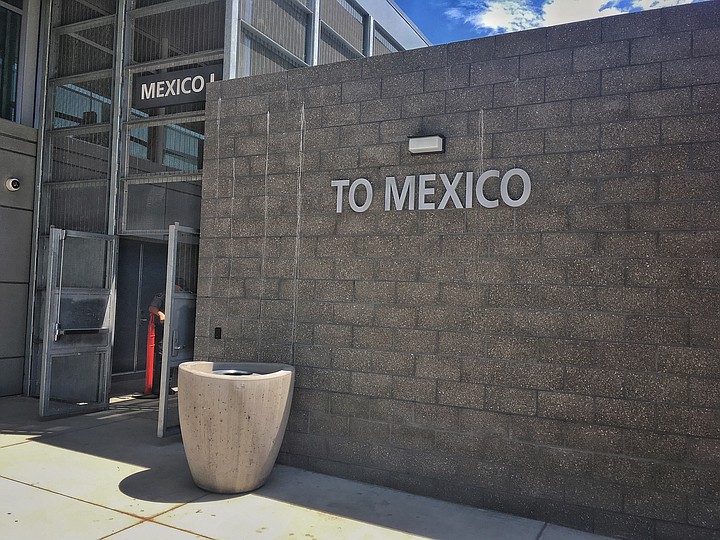
This new option will alleviate the pedestrian traffic spike that delays foreigners entering Tijuana for more than an hour on the weekends. It will save the 15-minute walk over the bridge to the eastern San Ysidro border for workers and shoppers from Las Americas outlet mall.

Northbound PedWest traffic operates 24 hours as do the northbound and southbound eastern San Ysidro border.
Besides the armed guards, I was the only person using the new entry way on Tuesday, August 1, at 2:18 pm.
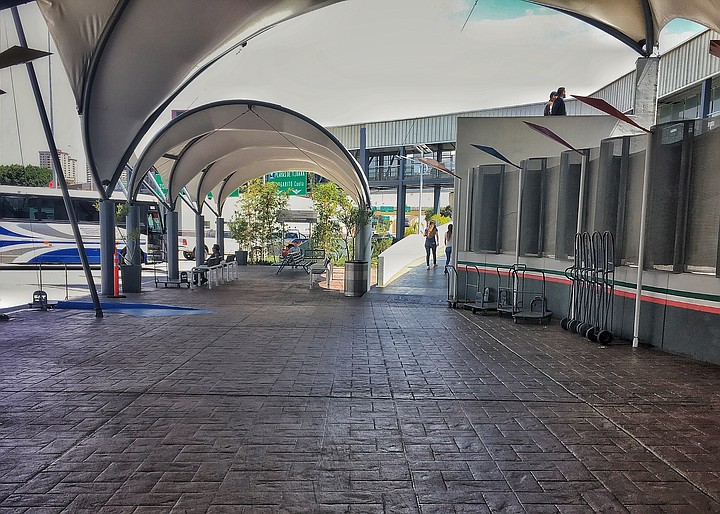
The first turnstile to exit the United States leads you to a hallway between the PedWest building and tall concrete walls fenced in with triple concertina wire.
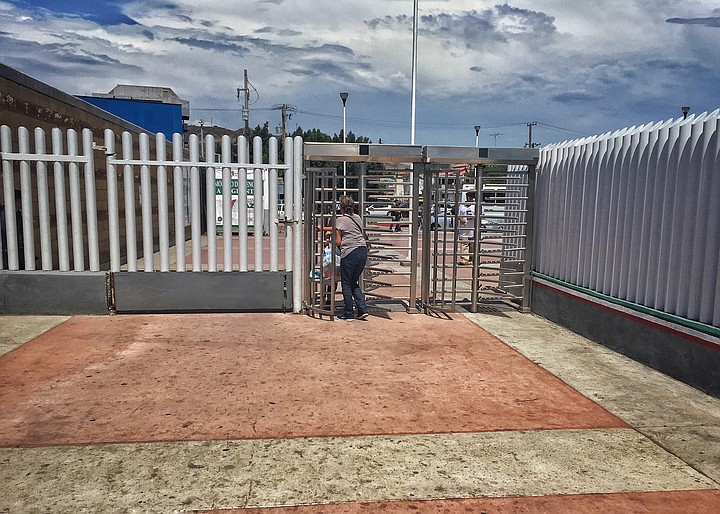
The second turnstile leads you to a small open space with a single Mexican Army soldier next to the spiral bridge where the northbound border wait usually starts. A long open hallway follows the Tijuana river, directly underneath the bridge that connects to PedWest.
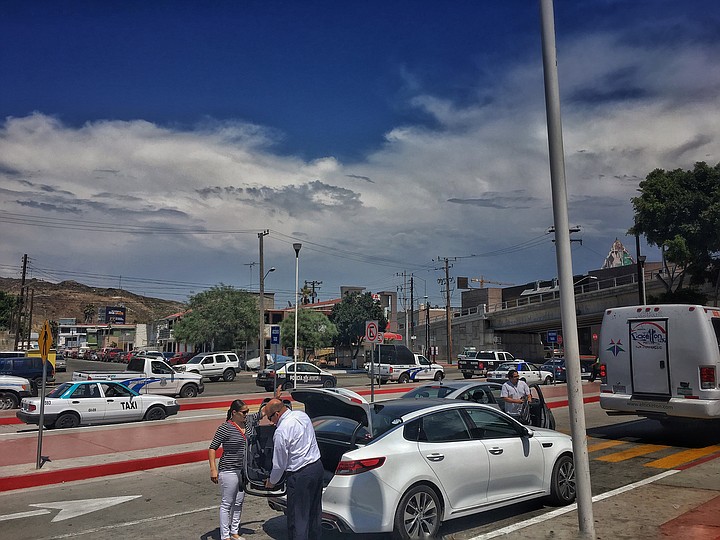
The hallway ends in a room with yawning Mexican border agents asking for proof of citizenship. I flashed them my Mexican passport without the need to open the booklet and I was through (my Mexican passport expired in April of 2006). After customs, there is a bigger second room with x-ray scanners and more bored agents for tax inspection of imported goods.
The exit is what used to be the entry of the PedWest bridge. The entry was pushed to the side.
Saturday morning, a couple of days before the inauguration of the new entry, the infamous yellow taxi union tried to claim the PedWest territory as their new border ground. The union placed family members in front of their taxis — women, children, elderly, and even people in wheelchairs, and said they wouldn’t move unless physical force was used. The union unexpectedly left, and police took the opportunity to seize the area.
The taxi drivers returned on Sunday with white and blue flags with political party PAN’s logo, supposedly, the same flags they used to support the election of Tijuana’s current mayor, Juan Manuel Gastelum. By that same afternoon, the yellow taxis were gone by their own will after authorities affirmed their decision to cancel their concessions and license plates if they remained in the area.
Following the mayor’s orders, the yellow taxi union was removed from the border on July 5. This was after members of the sindicato attacked Uber users. On July 12, a state judge for the disputes tribunal, Flora Arguilés Robert, ruled in favor of the yellow taxis, called the mayor’s orders unconstitutional and said she had “no guilty conscience” despite citizens' pleas against her decision and protests outside her office.
Though he earned his position with the support of the yellow taxi union, the mayor did not budge and did not allow the yellow taxis back to the border.
On July 26, the city filed for the dismissal of the state judge citing corruption, a lack of morality, and favoring a minority group with criminal ties.
On August 1st, federal judge Francisco Caballero Green, ruled in favor of the city after the yellow taxi union requested a writ of amparo (writ to protect individual rights) to get their border concessions back. The federal judge came to his determination after pondering the general interests of the citizens instead of the particular interests of the union.
Police now patrol both San Ysidro border entries; so do transportation officers that tell parked taxis to move along. I asked a transportation officer at PedWest what happened to the yellow taxis and he pointed to three gray “executive” taxis and told me those were the only ones approved taxis for the passenger pickup area.
“To downtown, the standard is five dollars,” said Felipe, the driver of the executive taxi in front of the line. An Uber ride usually charges half of that but I decided to give the taxi a try.
“We are a different gremio de taxistas (association of taxis), similar to the airport ones, but better,” said Felipe as I carried a casual conversation with him. “Yellow taxis won’t come back, we are here now, we are better,” continued Felipe circumventing the conversation in how they provide a better service on my uneventful, overpriced, and smooth ride to downtown Tijuana.


“It looks like I’m entering a ride in Six Flags,” regular border crosser Yesenia Huerta comments after using the new southbound entry to Tijuana via PedWest.

“It feels like you are getting out of prison,” differs Tamara Jiménez, another regular border crosser.
One year and two weeks after the United States opened the second option northbound through San Ysidro, known as PedWest, the new entry into Tijuana opened on Monday, July 31.

Located west of the vehicle border traffic, near Las Americas outlet mall, the second pedestrian option to enter Mexico through San Ysidro is open daily from 6:00 a.m. to 10:00 p.m.

This new option will alleviate the pedestrian traffic spike that delays foreigners entering Tijuana for more than an hour on the weekends. It will save the 15-minute walk over the bridge to the eastern San Ysidro border for workers and shoppers from Las Americas outlet mall.

Northbound PedWest traffic operates 24 hours as do the northbound and southbound eastern San Ysidro border.
Besides the armed guards, I was the only person using the new entry way on Tuesday, August 1, at 2:18 pm.

The first turnstile to exit the United States leads you to a hallway between the PedWest building and tall concrete walls fenced in with triple concertina wire.

The second turnstile leads you to a small open space with a single Mexican Army soldier next to the spiral bridge where the northbound border wait usually starts. A long open hallway follows the Tijuana river, directly underneath the bridge that connects to PedWest.

The hallway ends in a room with yawning Mexican border agents asking for proof of citizenship. I flashed them my Mexican passport without the need to open the booklet and I was through (my Mexican passport expired in April of 2006). After customs, there is a bigger second room with x-ray scanners and more bored agents for tax inspection of imported goods.
The exit is what used to be the entry of the PedWest bridge. The entry was pushed to the side.
Saturday morning, a couple of days before the inauguration of the new entry, the infamous yellow taxi union tried to claim the PedWest territory as their new border ground. The union placed family members in front of their taxis — women, children, elderly, and even people in wheelchairs, and said they wouldn’t move unless physical force was used. The union unexpectedly left, and police took the opportunity to seize the area.
The taxi drivers returned on Sunday with white and blue flags with political party PAN’s logo, supposedly, the same flags they used to support the election of Tijuana’s current mayor, Juan Manuel Gastelum. By that same afternoon, the yellow taxis were gone by their own will after authorities affirmed their decision to cancel their concessions and license plates if they remained in the area.
Following the mayor’s orders, the yellow taxi union was removed from the border on July 5. This was after members of the sindicato attacked Uber users. On July 12, a state judge for the disputes tribunal, Flora Arguilés Robert, ruled in favor of the yellow taxis, called the mayor’s orders unconstitutional and said she had “no guilty conscience” despite citizens' pleas against her decision and protests outside her office.
Though he earned his position with the support of the yellow taxi union, the mayor did not budge and did not allow the yellow taxis back to the border.
On July 26, the city filed for the dismissal of the state judge citing corruption, a lack of morality, and favoring a minority group with criminal ties.
On August 1st, federal judge Francisco Caballero Green, ruled in favor of the city after the yellow taxi union requested a writ of amparo (writ to protect individual rights) to get their border concessions back. The federal judge came to his determination after pondering the general interests of the citizens instead of the particular interests of the union.
Police now patrol both San Ysidro border entries; so do transportation officers that tell parked taxis to move along. I asked a transportation officer at PedWest what happened to the yellow taxis and he pointed to three gray “executive” taxis and told me those were the only ones approved taxis for the passenger pickup area.
“To downtown, the standard is five dollars,” said Felipe, the driver of the executive taxi in front of the line. An Uber ride usually charges half of that but I decided to give the taxi a try.
“We are a different gremio de taxistas (association of taxis), similar to the airport ones, but better,” said Felipe as I carried a casual conversation with him. “Yellow taxis won’t come back, we are here now, we are better,” continued Felipe circumventing the conversation in how they provide a better service on my uneventful, overpriced, and smooth ride to downtown Tijuana.
Comments